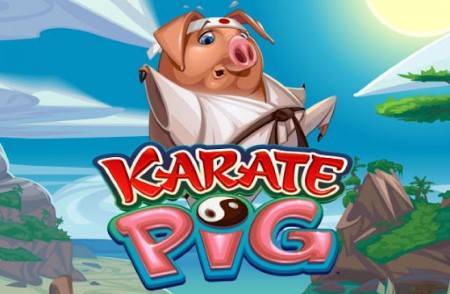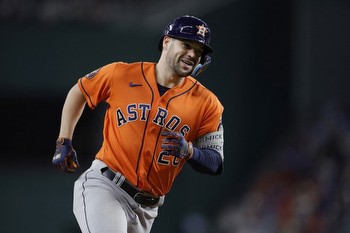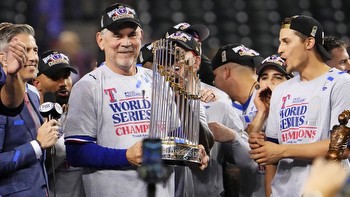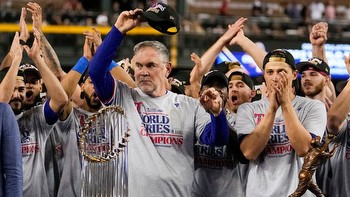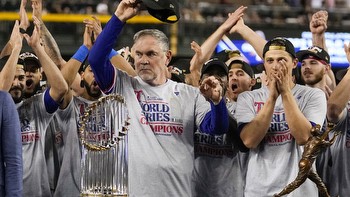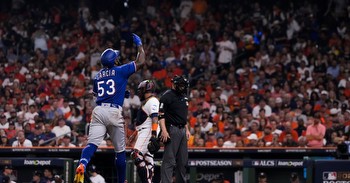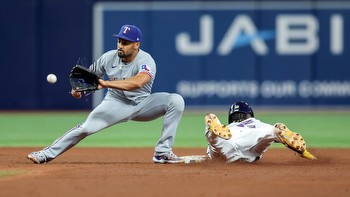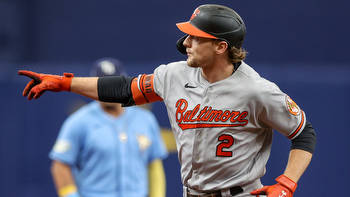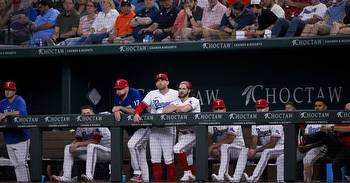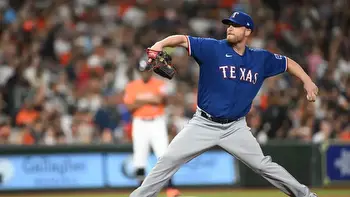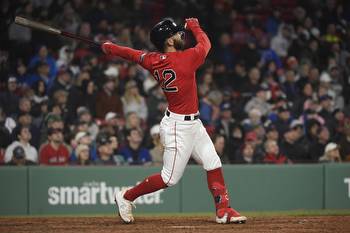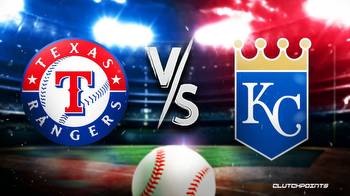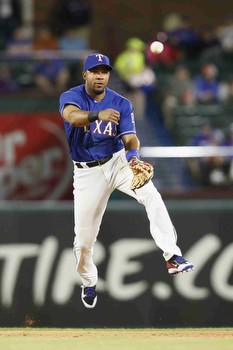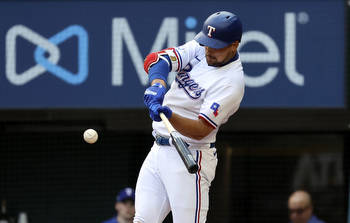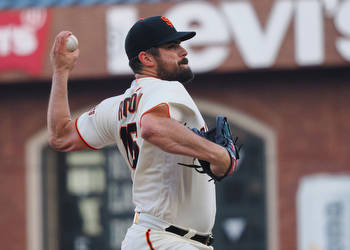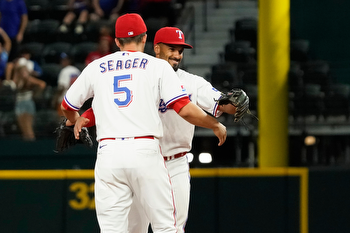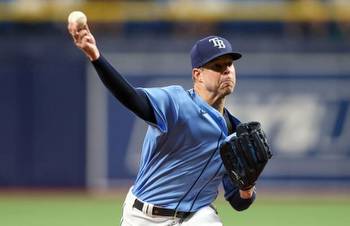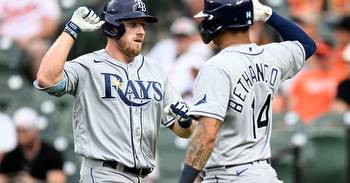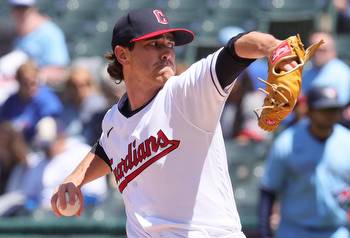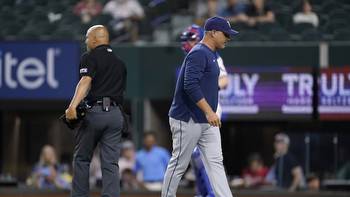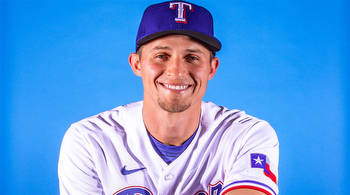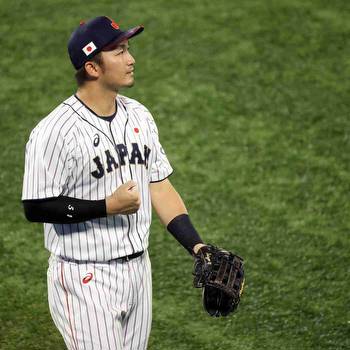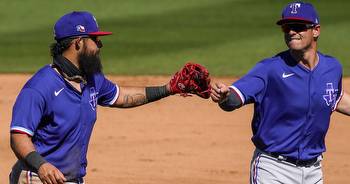The Trade Deadline Is Near. Let's Count Down the Rangers' Best Deals From the Last 15 Years
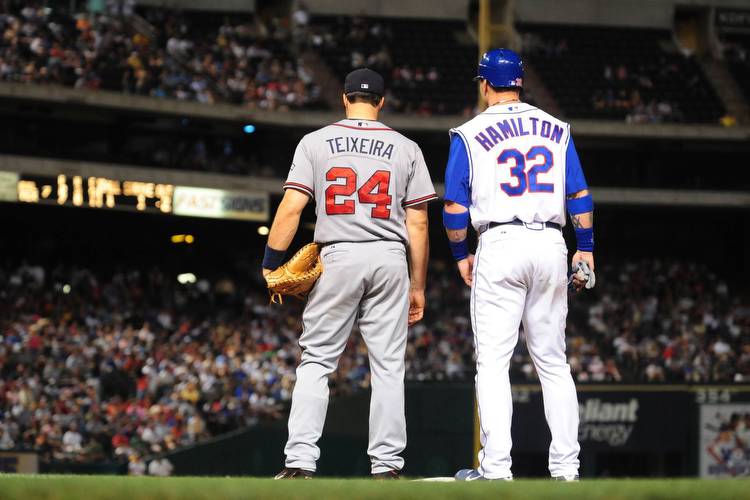
From a player acquisition standpoint, Chris Young’s tenure running things for the Rangers got off to a better start than it did for the man who hired him. While Jon Daniels’ first key free-agent signing, frontline starting pitcher Kevin Millwood, was a solid one, his first two big trades generated few warm-and-fuzzies then and even fewer in retrospect: a disgruntled Alfonso Soriano to the Nationals for Brad Wilkerson, Armando Galarraga, and Terrmel Sledge at the 2005 winter meetings and then, four weeks later, Adrian Gonzalez, Sledge, and Young himself to the Padres for Adam Eaton the Pitcher, Akinori Otsuka, and Billy Killian.
Young has already asserted himself loudly as a free-agency GM. He followed the Corey Seager/Marcus Semien/Jon Gray trifecta that Daniels and he masterminded in 2021 with an equally mind-blowing set of rotation moves last winter, signing Jacob deGrom, Nathan Eovaldi, and Andrew Heaney for a total of $244 million.
Daniels, on the other hand, distinguished himself through the trades he made, both in teardown fashion and go-for-it mode. With the Aug. 1 trade deadline looming and the Rangers sitting atop the A.L. West, we’re about to find out a lot more about Young’s appetite for the trade market and his ability to maneuver through it. Making trades is different from pushing bags of cash across the table. Money-whipping free agents has fewer competitive repercussions than player-whipping other teams at trade time.
Young got off to what appears to be a good start by picking up Aroldis Chapman in late June for Cole Ragans and 17-year-old outfielder Roni Cabrera. It will almost certainly not be the biggest trade Young makes before the deadline, as he looks for ways to improve a club positioned to make the playoffs for the first time in seven years. He’s almost sure to add at least one more reliever with swing-and-miss stuff. That would be reminiscent of what Daniels did in the final 36 hours before the 2011 trade deadline when he acquired Orioles closer Koji Uehara (for Chris Davis and Tommy Hunter) and Padres setup man Mike Adams (for pitching prospects Robbie Erlin and Joe Wieland) to deepen the bullpen behind Neftali Feliz as the Rangers kept their eyes trained on a second straight World Series appearance.
But first, let’s take a look back. In ranking the top 10 trades the Rangers have made since the cycle that led to those first two World Series, the Uehara/Adams one-two punch doesn’t quite make my list. Neither does Chapman; that one’s too early to call. If he ends up recording the one final strike that Feliz couldn’t, we can do this exercise again in four months.
My top 10:
10. December 8, 2020: RHP Lance Lynn to the White Sox for RHP Dane Dunning and minor leaguer LHP Avery Weems
Daniels capitalized on Lynn’s consecutive top-six finishes for the A.L. Cy Young by flipping the final season of his three-year contract to the White Sox for Dunning and Weems. It wasn’t the first time Dunning had been traded; the Nationals had sent their former first-round pick to Chicago four years earlier, along with more heralded righties Lucas Giolito and Reynaldo Lopez, in a deal for Adam Eaton the Outfielder.
Dunning lost his 2019 season to Tommy John surgery but got to the majors in 2020 and made seven pennant-race starts, six of which the White Sox won. He was a mainstay in the Rangers rotation in 2021 and ’22, pitching close to league-average baseball, but he was deposed to the bullpen in 2023 after Texas signed deGrom, Eovaldi, and Heaney to join Gray and Martin Perez in the starting five.
That is, until deGrom left his sixth start of the season with what would be a season-ending injury. Dunning has been one of the true heroes of the Rangers’ unexpected four-month run as one of MLB’s best teams, replacing deGrom in the rotation and allowing three earned runs or less in 11 of his 14 starts. Don’t count on Dunning being the odd man out of the rotation if Texas does trade for a starter in the next week.
9. July 29, 2021: OF Joey Gallo and LHP Joely Rodriguez to the Yankees for minor leaguers IF-OFs Ezequiel Duran, Josh Smith, and Trevor Hauver, and RHP Glenn Otto
Gallo had bounced back enough after a dreadful 2020 season to generate some level of trade interest at the 2021 deadline, but the four-player return from the Yankees came across as quarters on the dollar. Within a year, it became clear that Duran had more value than Gallo alone. And this summer, all the columns suggesting the Rangers are on a short list of teams positioned to trade for Shohei Ohtani identify Duran as the carrying piece in any Texas package.
The 24-year-old has improved offensively every year as a pro, an eye-opening trend given that he has faced better pitching each season. In Duran’s first year stateside with the Yankees, his rookie-ball OPS was .562. The next year, in short-season A ball, it jumped to .825. In 2021, splitting his season between the Yankees’ and Rangers’ High-A affiliates, he posted an .828 OPS. In 2022, between Double-A Frisco and Triple-A Round Rock, it was .899. That summer included a .642 major-league debut with the Rangers, which he has turned into an .851 this year.
Whether he’s the Rangers’ long-term left fielder here, a Swiss Army knife who hits every day while playing all over the field (he’s playing shortstop now in place of the injured Seager), or an exquisite trade asset, turning Gallo into Duran was a win. If any of the other three pieces in the deal carve out long-term roles in the big leagues, this deal has a chance to be much more.
8. December 10, 2020: Minor leaguers OFs Heriberto Hernandez and Alexander Ovalles and IF Osleivis Basabe to the Rays for 1B Nathaniel Lowe and minor leaguers 1B Jake Guenther and OF Carl Chester
Two years after signing with Tampa Bay as a 13th-round draft pick in 2016, Lowe had made himself a top-100 prospect and was in the major leagues the year after that. He acquitted himself well in 2019 and 2020, but was left off the Rays’ roster in 2020 for the ALDS, ALCS, and World Series.
Lowe was a player the Rangers had tried to trade for before, and they finally landed him, two days after trading Lynn for Dunning. It cost Texas two key 20-year-old prospects, the outfielder Hernandez and infielder Basabe, plus Ovalles, who had come over when the Rangers moved Cole Hamels to the Cubs in 2018. Hernandez, in particular, was viewed by both Texas and Tampa Bay as a player whose upside profiled similarly to what Lowe had already flashed. (Three years later, he’s struggling to rein in the strikeouts in Double-A, although Basabe has taken significant steps forward.)
Lowe was basically the same hitter for Texas in 2021 (.771 OPS) as he was in his two years with the Rays (.770 OPS). But in 2022, he was the American League’s Silver Slugger at first base, hitting .302 with an .851 OPS. This year his average and power have dipped, but he has been at his best this month, perhaps foretelling a second straight season in which his second half obliterates his first.
7. February 6, 2021: SS Elvis Andrus, C Aramis Garcia, and cash to the A’s for C Jonah Heim, DH Khris Davis, and minor leaguer RHP Dane Acker
When the Rangers resolved to move Andrus after 12 big-league seasons, it was viewed as a salary dump. The 32-year-old had just hit .194 in 2020 and still had $14 million salaries due in 2021 and ’22 plus a vesting $15 million option in 2023. Oakland was interested as long as Texas curbed the financial impact by taking on Davis’ contract and sending the A’s $13.5 million, which the Rangers were willing to do if it meant landing Heim and Acker, two prospects with very different backgrounds.
Acker, a fourth-round pick the summer before, had yet to throw a professional pitch. Meanwhile, Heim was being traded for the third time. A former fourth-rounder, he spent three-and-a-half seasons in the Baltimore system, a year and a half with the Rays, and three seasons with the A’s, with whom he got 41 plate appearances in a 2020 major-league debut. Heim was blocked by Sean Murphy, so Oakland was open to moving him, and the Rangers’ scouts circled his name.
Always considered a plus defender, Heim has shown staggering improvement with the bat. The switch-hitter posted a .598 OPS sharing catcher duties with Jose Trevino in 2021. Catching 111 times in 2022, he improved that mark to .697. This year, while on pace to catch more than 120 games, he has an OPS of .818, which trails only the Dodgers’ Will Smith at his position. There’s every chance the Heim trade is higher on this list in a year or two. It already might be too low.
6. December 21, 2019: Cash considerations to the Cardinals for OF Adolis Garcia
Garcia was a big-ticket signing for the Cardinals in 2017, landing a $2.5 million signing bonus as a 24-year-old with six years of experience in the Cuban National Series and in Japan. But he got only 17 plate appearances (and two starts) with St. Louis, all late in 2018, and after a full year in Triple-A the next year, the Cardinals designated him for assignment to make room for 31-year-old Korean lefthander Kwang Hyun Kim.
Three days later, Daniels offered cash to the Cardinals to keep them from running Garcia through waivers, and St. Louis accepted. The Rangers kept Garcia at their alternate training site for most of the truncated 2020 season (he had seven hitless plate appearances) and then made a similar decision to the one St. Louis made the winter before by designating Garcia for assignment in February 2021 to clear a roster spot for free agent pitcher Mike Foltynewicz. Based on the timing, Daniels believed he could get Garcia through league-wide waivers, even though he had a minor-league option season remaining. He was right.
Garcia made the All-Star team that year and finished fourth in the American League Rookie of the Year voting. He was better in 2022, improving his OPS from .741 to .756 while driving in 101 runs with upticks in his walk rate, his defense, and his baserunning while marginally slashing his strikeouts. He’s taken an even bigger leap in 2023, showcasing career-best plate discipline (raising his walk rate and lowering his strikeout rate by three percent apiece) as he returned to the All-Star game and leads all of baseball with 80 RBI.
5. January 25, 2011: RHP Frankie Francisco to the Blue Jays for C Mike Napoli
Just like Lowe, Daniels tried to acquire Napoli from the Angels for years, to no avail. But when the Rangers signed Adrian Beltre in January 2011—a fallback after they’d been spurned by Lee—it scuttled the Angels’ own plan, leaving them to send Napoli to the Blue Jays in a deal for outfielder Vernon Wells, their fallback to Beltre. Less than a week later, Daniels sent Francisco, a year removed from closing games for the Rangers, to Toronto in exchange for the player he long coveted.
Napoli demonstrated why Texas valued him so highly by turning in a career year. Splitting his time among catcher, first base, and DH, the 29-year-old hit .320 with 30 home runs in only 113 games in 2011, posting an OPS of 1.046. Had the Rangers closed out the Cardinals in the 2011 World Series, Napoli would have been a frontrunner for World Series MVP honors, as he hit .350/.464/.700 (1.164 OPS) with 10 RBI.
4. July 31, 2015: LHP Matt Harrison and minor leaguers C Jorge Alfaro, RHPs Jerad Eickhoff, Jake Thompson and Alec Asher, and OF Nick Williams to the Phillies for LHPs Cole Hamels and Jake Diekman and $9.5 million; plus minor leaguers C Tomas Telis and LHP Cody Ege to the Marlins for RHP Sam Dyson
After a brutal 2014, which followed four straight seasons of playing past 162, new manager Jeff Banister had the Rangers playing better in 2015. But Texas was three games below .500 and eight games back both in the AL West and wild-card races as the trade deadline neared, leaving the team to presumably look toward 2016. Then Daniels surprised the baseball world by shipping a handful of his best prospects to get Hamels (who was controllable through 2019), along with Diekman to add to the bullpen. That same day, Daniels also added Dyson, the Marlins’ set-up man, for fringe prospects Telis and Ege.
Then Texas went 39-22 (winning 10 of Hamels’ 12 starts) and reclaimed the West.
Although Alfaro, Thompson, and Williams were on every Internet top-100 prospects list, none of the prospects in the Philadelphia deal really panned out. Meanwhile, Hamels, Diekman, and Dyson were key components of a pitching staff that helped get the Rangers back into the playoffs not only in 2015 but the next season as well.
3. July 9, 2010: 1B Justin Smoak and minor leaguers RHPs Blake Beavan and Josh Lueke and 2B Matt Lawson to the Mariners for LHP Cliff Lee and RHP Mark Lowe
The Yankees had a deal all but done for Lee—a three-prospect package of Jesus Montero, Zach McAllister, and David Adams—but when the Mariners raised concerns about Adams’ recovery from an ankle injury, Daniels swooped in and agreed to a deal that included Smoak, a player the Yankees ranked ahead of Montero.
After an uneven summer with the Rangers (four wins in 15 starts and a 3.98 ERA), Lee was deGrom-level dominant in the first two rounds of the playoffs against the Rays and Yankees, winning all three starts—against David Price twice and then Andy Pettitte—each on the road. He allowed two runs on 13 hits and one walk with 34 strikeouts in 24 innings.
Lee didn’t fare as well in Game 1 or Game 5 of the World Series, outdueled in both by Giants ace Tim Lincecum. But his place in franchise history is indelibly etched, and the only reason we won’t name our next dog Cliff Lee is if my wife holds her ground.
2. December 21, 2007: RHP Edinson Volquez and minor leaguer LHP Danny Ray Herrera to the Reds for OF Josh Hamilton
Five months later, the Rangers took an even bigger risk than betting on Andrus, Harrison, and Feliz. Though they had experienced systemic challenges developing pitchers, they were not only willing to move Volquez, who a year earlier was considered one of the game’s most promising pitching prospects after blazing his way from Class A to Arlington inside of a season. They were also doing it for Hamilton, who had just finished his rookie season with the Reds after six years in and out of drug rehab cycles and league suspensions while with the Rays.
It was just as catalytic as the trade with Atlanta, though in different ways. Hamilton finished seventh in the MVP race in his first year with Texas. He earned a pair of MVP trophies two years later, both for his regular season (when he led all of baseball with a .359 batting average, a .633 slugging percentage, and a 1.044 OPS) and his .350/.536/1.000 series with four home runs against the Yankees in the ALCS, a six-game affair that culminated with the Rangers’ first trip to the World Series.
The next year, Hamilton had a very good regular season (.298/.346/.536), even if not at 2010’s level. But in typical, sandlot-level, unassuming Josh Hamilton fashion, minutes after a World Series title had eluded Nelson Cruz’s glove by inches, he blasted that two-run, 10th-inning home run that would have stood as the biggest moment in franchise history had the Rangers not blown a second lead in the bottom of the inning.
1. July 31, 2007: 1B Mark Teixeira and LHP Ron Mahay to the Braves for C Jarrod Saltalamacchia and minor leaguers SS Elvis Andrus, RHP Neftali Feliz, and LHPs Matt Harrison and Beau Jones
Though it’s commonplace now, this was one of the first times a superstar was traded at the deadline in a year that wasn’t his last before free agency. The Rangers believed they could get the most for Teixeira—who in his four-plus seasons had been a two-time Silver Slugger, a two-time Gold Glover, and had a .901 OPS—by moving him a year earlier than many assumed they would. Did it ever pay off.
Daniels wanted 19-year-old Clayton Kershaw, a year after he had graduated from Highland Park High School, but the Dodgers said no. He then turned down the Diamondbacks’ offer of two top-50 prospects in lefthander Brett Anderson and outfielder Carlos Gonzalez, plus a young major-league hitter (outfielder Carlos Quentin or first baseman Conor Jackson) and opted for what was a less glitzy offer from the Braves. It turned out to be the Rangers’ Herschel Walker trade.
Saltalamacchia was the headliner because he’s the player ESPN and the newspapers had heard of, but the keys for Texas were Andrus (age 18 and in Class A), Harrison (21 and in Double-A), and Feliz (19 and with only 19 rookie-level minor league appearances in two years). Jones was added at the last minute when the Rangers raised some concerns about Harrison’s medicals, while Daniels tossed in Mahay, a 36-year-old middle reliever who was of little use to a franchise that was rebuilding.
The Teixeira trade set in motion a run of two pennants and seven years out of eight with 87 to 96 wins. The Rangers don’t need a deal as good as that—or any of the others on this list—to better its World Series odds. But if they find one, together with the talent already on this roster, it could be the catalyst for finally ending that World Series drought.
Jamey Newberg covers the Rangers for StrongSide. He has lived in Dallas his entire life, with the exception of a…
